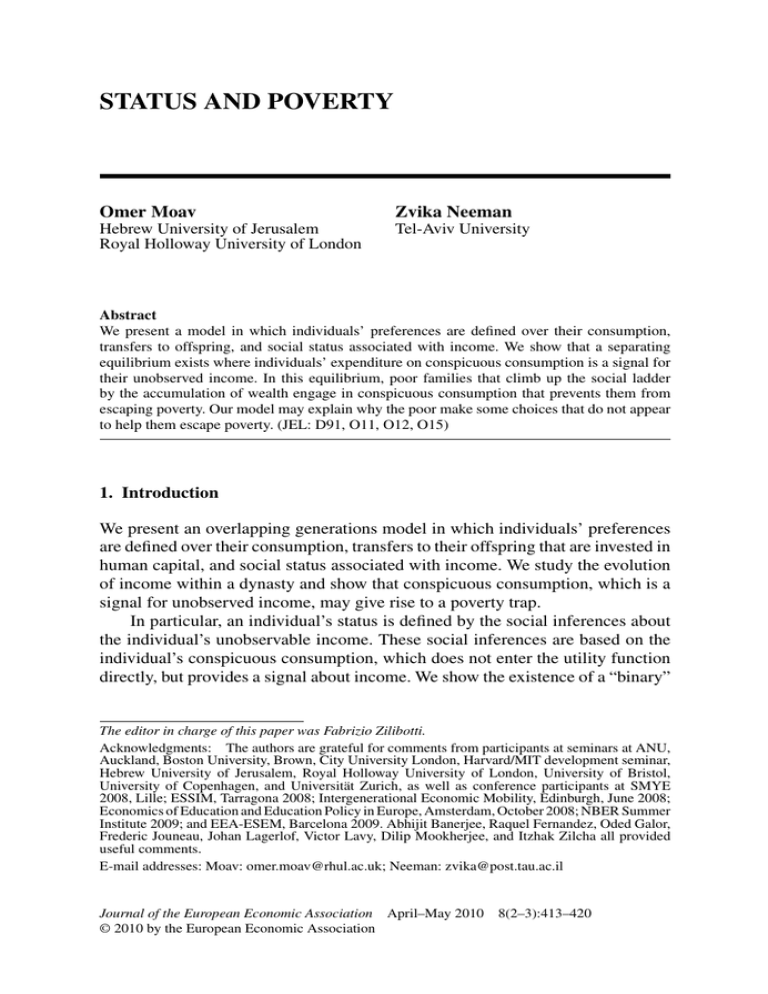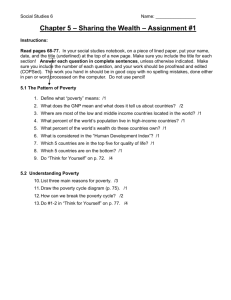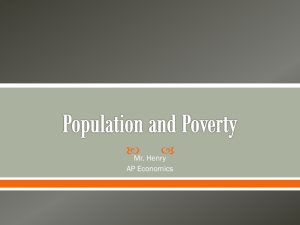STATUS AND POVERTY Omer Moav Zvika Neeman Hebrew University of Jerusalem
advertisement

STATUS AND POVERTY Omer Moav Zvika Neeman Hebrew University of Jerusalem Royal Holloway University of London Tel-Aviv University Abstract We present a model in which individuals’ preferences are defined over their consumption, transfers to offspring, and social status associated with income. We show that a separating equilibrium exists where individuals’ expenditure on conspicuous consumption is a signal for their unobserved income. In this equilibrium, poor families that climb up the social ladder by the accumulation of wealth engage in conspicuous consumption that prevents them from escaping poverty. Our model may explain why the poor make some choices that do not appear to help them escape poverty. (JEL: D91, O11, O12, O15) 1. Introduction We present an overlapping generations model in which individuals’ preferences are defined over their consumption, transfers to their offspring that are invested in human capital, and social status associated with income. We study the evolution of income within a dynasty and show that conspicuous consumption, which is a signal for unobserved income, may give rise to a poverty trap. In particular, an individual’s status is defined by the social inferences about the individual’s unobservable income. These social inferences are based on the individual’s conspicuous consumption, which does not enter the utility function directly, but provides a signal about income. We show the existence of a “binary” The editor in charge of this paper was Fabrizio Zilibotti. Acknowledgments: The authors are grateful for comments from participants at seminars at ANU, Auckland, Boston University, Brown, City University London, Harvard/MIT development seminar, Hebrew University of Jerusalem, Royal Holloway University of London, University of Bristol, University of Copenhagen, and Universität Zurich, as well as conference participants at SMYE 2008, Lille; ESSIM, Tarragona 2008; Intergenerational Economic Mobility, Edinburgh, June 2008; Economics of Education and Education Policy in Europe, Amsterdam, October 2008; NBER Summer Institute 2009; and EEA-ESEM, Barcelona 2009. Abhijit Banerjee, Raquel Fernandez, Oded Galor, Frederic Jouneau, Johan Lagerlof, Victor Lavy, Dilip Mookherjee, and Itzhak Zilcha all provided useful comments. E-mail addresses: Moav: omer.moav@rhul.ac.uk; Neeman: zvika@post.tau.ac.il Journal of the European Economic Association April–May 2010 © 2010 by the European Economic Association 8(2–3):413–420 414 Journal of the European Economic Association partially separating equilibrium, in which it is possible to infer whether an individual’s income is above or below a certain arbitrary threshold, or more generally, whether an individual belongs to the high or low income class. In this equilibrium, poor families who climb up the social ladder by the accumulation of wealth engage in conspicuous consumption, and thereby enjoy the status of the high income class. We interpret this as an attempt by the poor to distinguish themselves from the very poor. However, generating this signal is costly and requires a large fraction of their income, which may prevent further wealth accumulation, and they may eventually fall back to poverty. Sufficiently wealthy individuals, however, can signal their status while maintaining their wealth, as the signal requires a smaller fraction of their income. Thus, our model provides an explanation for the perplexing behavior of the poor, who appear to be able to do more to improve their situation, but instead spend a large fraction of their income on goods that do not alleviate poverty.1 We suggest that this is a result of an inefficient signaling equilibrium. In this equilibrium, individuals care about their status and seek to impress others by engaging in conspicuous consumption. This behavior indeed provides a correct signal about the individuals’ income, but interferes with the accumulation of wealth that is necessary to escape poverty. In a closely related paper (Moav and Neeman 2009) we further suggest that there is a trade-off between conspicuous consumption and observable human capital as signals for unobserved income. We demonstrate that this trade-off produces a signaling equilibrium in which expected expenditure on conspicuous consumption as a fraction of total income is decreasing with human capital, which in turn gives rise to an increasing marginal propensity to save that can generate a poverty trap. Focusing on a fully separating equilibrium, we show in Moav and Neeman (2009) that this trade-off between human capital and conspicuous consumption as a signal for income is crucial for the emergence of a poverty trap. In contrast, in the simpler model presented here, human capital is assumed to be unobservable, and our focus is on “binary” partially separating equilibria, as described herein. These binary partially separating equilibria may give rise to a poverty trap even though human capital is not observable. Thus, this short paper presents a simple framework for the main insight in Moav and Neeman (2009), and extends the range of the analysis by considering different equilibria. Thus, our theory offers an explanation for the persistence of poverty that is consistent with the perplexing behavior of the poor, as mentioned previously. Of course, one could offer alternative, or complementary, explanations for these puzzling consumption patterns. For example, in many places there is a 1. See, for example, Banerjee and Duflo (2007) who claim that the poor in some regions of India spend as much as 10% of their annual income on festivals but only 2–3% of their income on their children’s education, and, moreover, refrain from sending a large fraction of their children to school. Additional examples are surveyed by Moav and Neeman (2009). Moav and Neeman Status and Poverty 415 social norm of lavish spending on festivals. But this only means that failing to follow such norms is a signal for one’s dire financial situation. Another alternative explanation is based on difficulties with self control or succumbing to temptation (Banerjee and Mullainathan 2007). However, this self control issue may very well be due to the fact that people seek immediate gratification of their desire to make a positive impression on others. There is a large literature that offers explanations for the persistence of poverty. Most of this literature (see, e.g., Dasgupta and Ray 1986; Banerjee and Newman 1993; Galor and Zeira 1993) focuses on credit constraints as the main obstacle preventing the poor from passing the threshold of investment required to escape from poverty. However, while the evidence suggests that the poor do have limited access to credit,2 there is little empirical support for the existence of significant investment indivisibilities. Moreover, this approach is silent about evidence that suggests that the poor could improve their situation if they saved more and spent less on goods that do not appear to alleviate poverty. That a poverty trap can also arise, regardless of investment indivisibilities, if individuals’ propensity to save increases with income, was noted in the literature (see Moav 2002).3 The rise in the saving rate with income is supported by the empirical literature (Dynan, Skinner, & Zeldes 2004). Here we present a mechanism that explains why such a tendency should be observed, regardless of non-homothetic preferences. The signaling equilibrium implies that, above some threshold, the fraction of income allocated to conspicuous consumption declines with income, and hence the saving rate is increasing with income. There is also a vast literature on conspicuous consumption that dates at least to Smith (1759) and Veblen (1899), however, this literature has not dealt with the issues discussed in this paper. 2. Model Consider an overlapping-generations economy that operates in a one-good world. Economic activity extends over infinite discrete time in a competitive environment. In each period, adult individuals allocate their income between their own consumption, a bequest to their offspring, and conspicuous consumption, which is a costly signal about their wealth. In equilibrium social beliefs about an individual’s wealth that are based on this signal are accurate in expectation. 2. See, for example, Besley (1995). 3. Moav (2005) shows that despite homothetic preferences, defined over consumption and the quality and quantity of children, a poverty trap can emerge. Less-educated individuals have a comparative advantage in producing child quantity, and as a result saving rates, in the form of investment in child quality, are increasing with income. 416 Journal of the European Economic Association 2.1. Individuals Individuals, within as well as across generations, are identical in their preferences and their technology of human capital formation. They may differ, however, in their initial wealth, inherited from their parents. Hence, due to capital market imperfection, their investment in human capital could differ as well. In particular, it is assumed that individuals cannot borrow in order to finance investment in human capital. An individual lives for two periods, has a single parent, and bears a single child; the parent–child connection creates a dynasty. When an individual is in her first life period, her parent is in the second. In their first life period, young individuals invest in their own human capital and physical capital. In their second life period they are adults who supply inelastically one unit of time to the labor market. Labor is, however, augmented by the accumulation of human capital. Individuals allocate their second life period income, y, between household consumption, c, conspicuous consumption, x, and a bequest to their offspring, b. Hence, the budget constraint is given by y = c + b + x. (1) Preferences are defined by the utility function u= c1−β bβ S(x), (1 − β)1−β β β (2) where 0 < β < 1 is a parameter that captures the relative preference over consumption relative to bequest, and S(x) is the individual’s status which is a function of social beliefs about the individual’s wealth as determined by her level of conspicuous consumption, x. It follows from maximizing utility (2) subject to the budget constraint (1) that the transfer of each individual to her offspring is b = β(y − x), (3) c = (1 − β)(y − x). (4) and that consumption is Plugging equations (3) and (4) back into the individuals’ utility function (2), it follows that u = (y − x)S(x). (5) Moav and Neeman Status and Poverty 417 2.2. A Binary Equilibrium Suppose that equilibrium beliefs are as follows: If an individual’s level of conspicuous consumption is below a certain arbitrary threshold x̄ then it is believed that her income is below a threshold ȳ. If, however, x ≥ x̄ then it is believed that y ≥ ȳ. An individual’s status is therefore given by the function S H if x ≥ x̄, S(x) = S L if x < x̄. Under these beliefs, individuals choose their level of conspicuous consumption so as to maximize the utility function (5). It follows that their level of conspicuous consumption as a function of their income y is given by x̄ if y ≥ ȳ, (6) x= 0 if y < ȳ, where ȳ = x̄S H . SH − SL (7) It is straightforward to verify that the social beliefs S(x) are, in turn, consistent with individuals’ behavior. It follows from (3) and (6) that bequest as a function of income y is β(y − x̄) if y ≥ ȳ, b= (8) βy if y < ȳ. 2.3. The Dynamical System In the first period of their lives, individuals devote their entire time for the acquisition of human capital (measured in efficiency units). The acquired level of human capital is a function of investment of real resources in education. In particular, the level of human capital, h, is a piecewise linear, increasing, and concave function of real resources invested in education, e,4 γ e if e < ē, h = h(e) = (9) γ ē if e ≥ ē. 4. This human capital production function could be replaced by a strictly concave function with no effect on the qualitative results. 418 Journal of the European Economic Association Figure 1. The evolution of income. It is assumed that for e < ē the marginal return to human capital γ is larger than the marginal return to physical capital R and that the wage rate per unit of human capital is set to one, or γ > R. (Assumption 1) This assumption ensures that individuals invest in human capital. Under assumption 1, the second period income of an individual who is born in time t, denoted yt+1 , is uniquely determined by the bequest received by this individual, denoted bt , in the following way: γ bt if bt < ē, (10) yt+1 = y(bt ) ≡ γ ē + R(bt − ē) if bt ≥ ē. Hence, it follows from equations (8) and (10) that the evolution of income within a dynasty is uniquely determined. That is, yt+1 is uniquely determined given yt by the following dynamical system, depicted in Figure 1: ⎧ ⎪ if yt < ȳ, ⎨γβyt (11) yt+1 = φ(yt ) = γβ(yt − x̄)) if yt ∈ [ȳ, ē/β + x̄], ⎪ ⎩ γ ē + R(β(yt − x̄) − ē) if yt > ē/β + x̄, where y0 is given per dynasty. (Note that β(yt −x̄) < ē if and only if yt < ē/β+x̄). Additional restrictions on the parameter values are required in order for the dynamical system to generate multiple income level steady states. The first two such restrictions are βγ > 1 and βR < 1. (Assumption 2) Moav and Neeman Status and Poverty 419 The first inequality allows for wealth accumulation within a dynasty over time, whereas the second assures that wealth accumulation is limited. Note that Assumption 2 implies Assumption 1. The third assumption is γβ SH . < SH − SL (γβ)2 − 1 (Assumption 3) It implies, under Assumption 2, that S H /(S H − S L ) < γβ/(γβ − 1), and hence that γβ(ȳ − x̄)) < ȳ. Thus, Assumption 3 implies that φ(ȳ) < ȳ, which is instrumental in generating a poverty trap. In order to ensure a high income steady state exists, it is assumed that ē > β x̄ . βγ − 1 (Assumption 4) Assumption 4 implies that β(γ ē − x̄)) > ē, or that φ(ē/β + x̄) > ē/β + x̄. This ensures the existence of a high income steady state. Finally, under Assumption 3 γβ(γβ ȳ − x̄) < ȳ, which implies that an escape from the poverty trap is not possible. Note that an individual with income ȳ − ε, where ε → 0, will transfer to her offspring b = β ȳ, and the offspring in turn will therefore have an income of γβ ȳ > ȳ. Hence, the offspring will consume x̄ units of income as conspicuous consumption, and transfer to the next generation β(γβ ȳ − x̄), which in turn generates an income of γβ(γβ ȳ − x̄), which, under A3, is less than ȳ. Assumptions 1–3 ensure that there exists a threshold income above which dynasties converge to a high income steady state, y H . In this “high” steady state, individuals enjoy an income from a high level of human capital and income from physical capital. Conspicuous consumption is also at a high level but is a relatively small fraction of overall income. Below the threshold dynasties converge to low income cycles. Wealth is accumulated over time, but once it hits the threshold ȳ it falls back again. 3. Concluding Remarks We develop a simple model that is based on the idea that individuals care about their status and seek to impress others by engaging in conspicuous consumption, which provides a signal about their income. Our model illustrates the possibility that the persistence of poverty may be partly due to an inefficient signaling equilibrium. In particular, we focus on binary partially separating equilibria in 420 Journal of the European Economic Association which poor individuals differentiate themselves from the very poor. Under some parameter values, this equilibrium can generate a poverty trap. Very poor dynasties gradually accumulate wealth, but converge back to poverty once they cross a threshold above which they start signaling their success. Sufficiently rich individuals, on the other hand, can afford to signal their success while maintaining their wealth. There may exist also other separating equilibria in which more than just two income classes can be distinguished, but these equilibria are qualitatively similar to the binary equilibrium described here. A fully separating equilibrium in which signaling is continuous in income fails to generate a poverty trap in this setting. This case is analyzed in Moav and Neeman (2009), where a poverty trap is shown to exist even in a fully separating equilibrium, provided that human capital is observable and correlated with income. References Banerjee, Abhijit, and Esther Duflo (2007). “The Economic Lives of the Poor.” Journal of Economic Perspectives, 21, 141–167. Banerjee, Abhijit, and Sendhil Mullainathan (2007). “Climbing Out of Poverty: Long Term Decisions under Income Stress.” BREAD Working paper, Harvard. Banerjee, Abhijit, and Andrew Newman (1993). “Occupational Choice and the Process of Development.” Journal of Political Economy, 101, 274–298. Besley, Tim (1995). “Savings, Credit and Insurance.” In Handbook of Development Economics, Volume 3A, edited by Jere Behrman and T. N. Srinivasan. Elsevier. Dasgupta, Partha, and Debraj Ray (1986). “Inequality as a Determinant of Malnutrition and Unemployment: Policy.” Economic Journal, 96, 1011–1034. Dynan, K. E., J. Skinner, and S. P. Zeldes (2004). “Do the Rich Save More?” Journal of Political Economy, 112, 397–444. Galor, Oded, and Joseph Zeira (1993). “Income Distribution and Macroeconomics.” Review of Economic Studies, 60, 35–52. Moav, Omer (2002). “Income Distribution and Macroeconomics: The Persistence of Inequality in a Convex Technology Framework.” Economics Letters, 75, 187–192. Moav, Omer (2005). “Cheap Children and the Persistence of Poverty.” Economic Journal, 115, 88–110. Moav, Omer, and Zvika Neeman (2009). “Saving Rates and Poverty: The Role of Conspicuous Consumption and Human Capital.” Working paper, Royal Holloway, University of London. Smith, Adam (1759). The Theory of Moral Sentiments. Reprint, Arlington House, 1969. Veblen, Thorstein (1899). The Theory of the Leisure Class. Macmillan.







